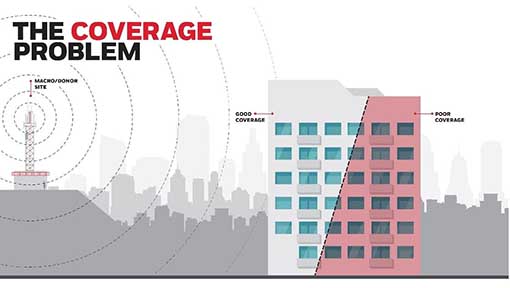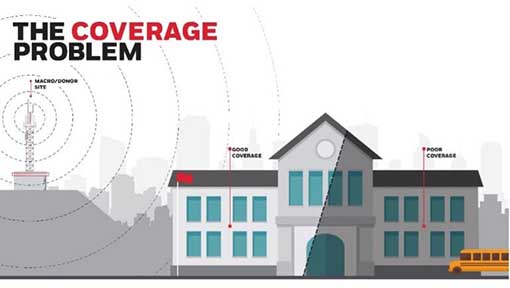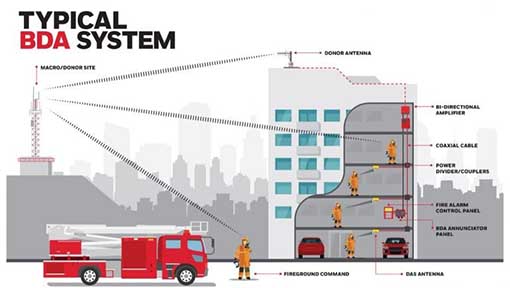PUBLIC SAFETY BDA & DAS (ERCES)
What is Public Safety DAS?
Public safety radio systems need to be 100% reliable, with comprehensive coverage inside and outside of buildings. Public safety BDA and DAS solutions are built to guarantee communications for police, fire and first responder’s radio systems. Also, new construction of commercial buildings and large apartment complexes are now required to have public safety systems that comply with the National Fire Protection Association (NFPA) standards. Bottom line the radios need to work inside these structures to help save lives.
A public safety DAS system often has these critical components:
- The donor antenna receives the signal from public safety radio system and a BDA (bi-directional amplifier) amplifies those signals, and then evenly distributes the amplified signals throughout the building via the Distributed Antenna System (DAS).
- The DAS is the in-building network of coax cables, splitters, & antennas
- In larger facilities, DAS will be designed using fiber to avoid signal loss over long distances
- The battery backup system ensures that the system operates in the event of power failure
The Problem: Poor Radio Coverage Inside Buildings & Schools:


The Solution: A BDA System :


Emergency Responder Radio Coverage Systems
Industrial Communications' Emergency Responder Radio Coverage Systems (ERCES) are engineered to support P25 first responder communication systems using a wide range of two-way radio frequency (RF) spectrums to meet the requirements of virtually any jurisdiction:
- VHF (150 MHz -170 MHz)
- UHF (450 MHz -512 MHz)
- 700 MHz /800 MHz
- FirstNet® / Band 14
Primary Applications for Public Safety BDA-DAS Systems
- New building construction
- Residential Apartment Complexes
- Expanding existing facilities or buildings
- Bringing older buildings up to code
Safety Codes Requiring Adequate Public Safety ERRC
Below is information on state fire codes. Most local jurisdictions will enforce amended versions or use different codebooks. Industrial Communications' DAS experts stay up to date on all these changes. We have relationships with many of the AHJs and understand specifically how they are interpreting code compliance. Contact us to find the local emergency responder radio code requirements for your project and area.
Florida State Statute 633.202 (18)
On June 24, 2022, Florida SB 1190 was signed into law by Gov. Ron DeSantis. Florida Fire Prevention Code (FFPC) requires adequate public safety communications coverage inside buildings (new and existing). Low-rise (less than 75 feet) buildings are NOT exempt from FFPC requirements for in-building public safety communications coverage.
These changes were effective July 1, 2022.
Read the full SBC Code Advisory
NFPA 72® (National Fire Alarm and Signaling Code)
Keeping up to code can be a difficult job for building operators. Regulations and requirements are constantly being updated and can vary by location. Regulations for public safety wireless are established by the National Fire Protection Association (NFPA) and International Fire Code (IFC).
The National Fire Protection Association drafted NFPA 72: National Fire Alarm and Signaling Code, which provides the latest safety provisions to meet society’s changing fire detection, signaling and emergency communications demands. NFPA 72 requires the use of a public safety distributed antenna system (DAS) strictly for use by first responders. While DAS can be essential for tenants or personnel within your building to communicate effectively on an everyday basis, public safety DAS is installed to enable first responders within the building to communicate during an emergency and must also have an alternative power source in case of a power outage.
NFPA 1221
Standard for the installation, maintenance and use of emergency services communications systems that covers all aspects of service delivery, from receiving calls to dispatching emergency units to the correct location in the appropriate time period.
International Fire Code Section 510
Section 510 of the International Fire Code specifies that “buildings and structures which cannot support the required level of radio coverage shall be equipped with a radiating cable system, a distributed antenna system with Federal Communications Commission (FCC)-certified signal boosters, or other systems approved by the fire code official in order to achieve the required adequate radio coverage.”
NFPA 1225 (COMING SOON)
NFPA 1225 incorporates and clarifies sections of NFPA 1061 and NFPA 1221 into one complete Standard for Emergency Services Communications.
